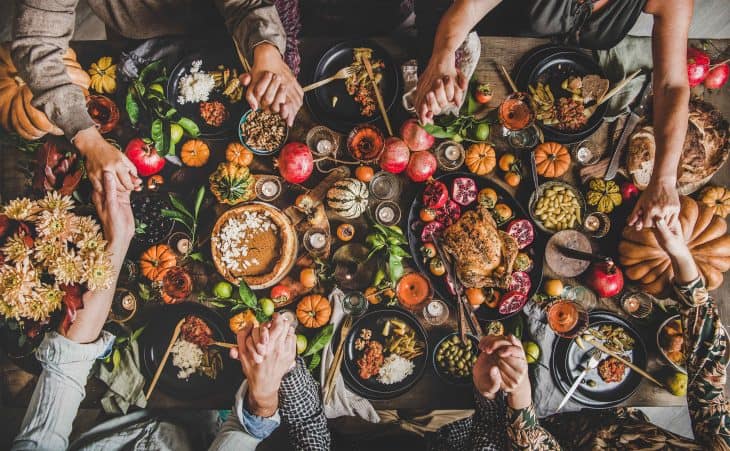
As the biggest holiday in the USA, Thanksgiving plays a big part in the American culture. Even more widely practiced than Christmas, most families use this time to get together and reflect on their year. However, there’s more to this holiday than the turkey and cranberry sauce on your table. Discover the history and origins of this festivity with these Thanksgiving facts.
- American law sets the Thanksgiving holiday on the fourth Thursday of November.
- Thanksgiving is one of 3 major holidays for the USA’s fall-winter holiday season, including Christmas and New Year.
- On average, 276 million Americans eat around 46 million turkeys on Thanksgiving.
- Americans spend around $1.05 billion on turkeys every year for Thanksgiving.
- Around 78% of government and private employees take Thanksgiving and the day after off.
- The first Thanksgiving traditionally took place in 1621, at the Plymouth Plantation.
- The Continental Congress first declared a national Thanksgiving holiday in 1777.
- George Washington ordered a second Thanksgiving at the end of that same year to celebrate the British defeat at Saratoga.
- President Abraham Lincoln set the last Thursday of November as Thanksgiving in 1863.
- President Grant included Thanksgiving in a list of federal holidays in 1870.
- The US Congress made Thanksgiving and other federal holidays paid ones in 1885.
- The Southern States largely did not celebrate Thanksgiving until the late-19th Century.
- It took until 1939 for President Franklin D. Roosevelt t0 move Thanksgiving to the fourth Thursday of November.
- Critics of President Roosevelt called the new date Franksgiving for years afterward.
- In 1942, the US Congress fixed Thanksgiving on the fourth Thursday of November.
- Canadians have their own Thanksgiving holiday on the second Monday of October.
- Americans consider it a bad form to start advertising for Christmas before Thanksgiving.
- Giving Tuesday takes place 5 days after Thanksgiving.
- Blackout Wednesday takes place the day right before Thanksgiving.
- Black Friday takes place the day right after Thanksgiving.
Thanksgiving Facts Infographics
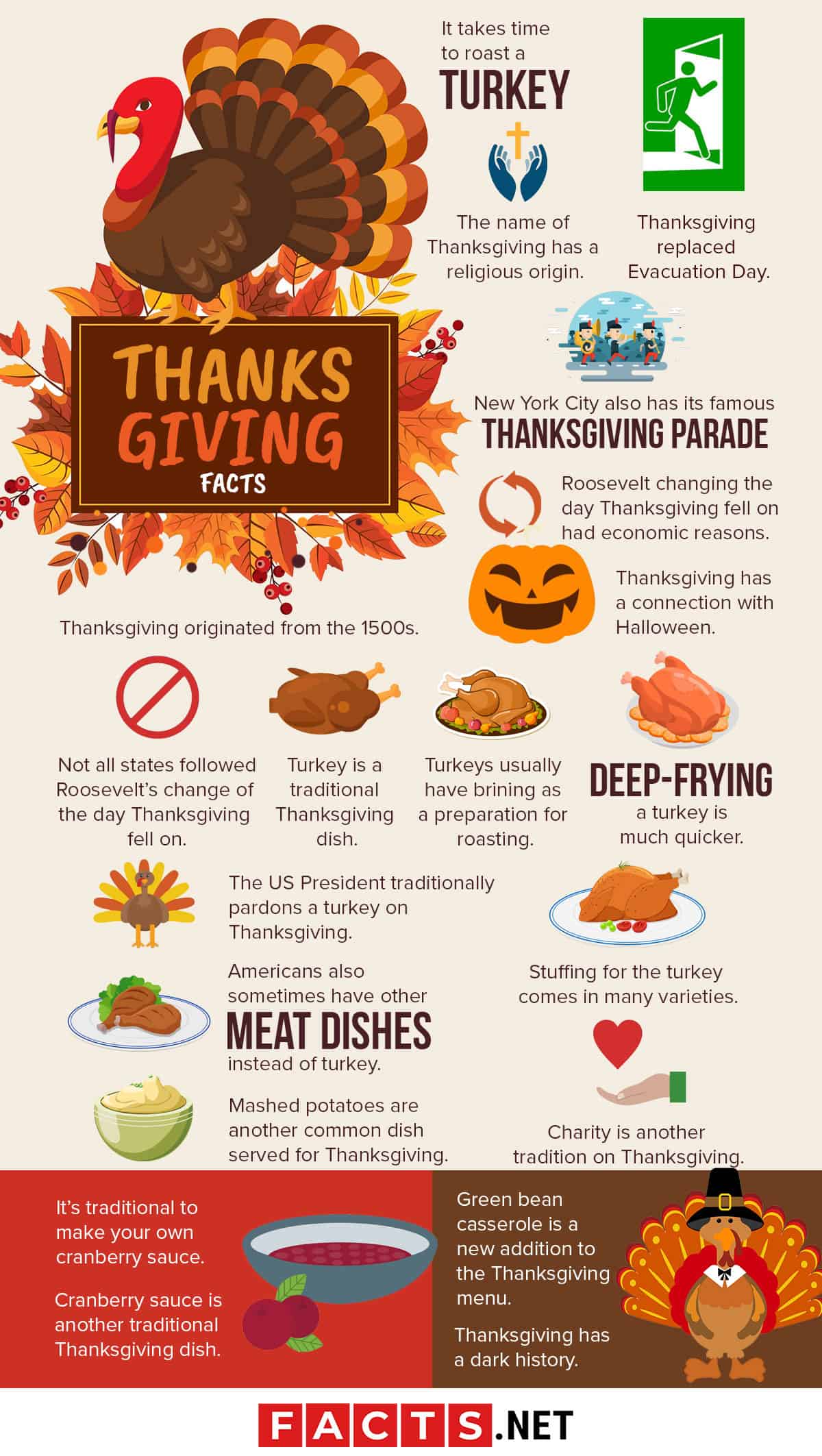
Thanksgiving originated from the 1500s.
One of the most unexpected Thanksgiving facts is that it originated from pre-Christian times. Thanksgiving traces its beginnings to the harvest and religious festivals of Europe, with settlers bringing the tradition with them as they discovered and colonized the North American continent.
The first Thanksgiving-like celebration in North America actually took place in 1541, held by Spanish explorers under Francisco de Coronado. In 1607, English colonists in what is now known as Virginia began celebrating Thanksgiving-like gatherings regularly.
The name of Thanksgiving has a religious origin.
The English first used the term in 1619 as a way to thank God for the safe arrival of their ships in North America. These settlers also became the first to celebrate it annually as a religious affair. Later on, the modern interpretation took on the meaning of honoring the Native Americans who shared their food with the settlers in 1621.
If not for the Natives’ help, the settlers would have starved. In fact, the natives also taught the settlers about corn and how to grow and harvest it. This is where the traditional depiction of English settlers and Native Americans celebrating the first Thanksgiving together comes from.
Thanksgiving celebrations depended on the US President during the USA’s early years.
Prior to having a designated date, the US President needed to declare a Thanksgiving holiday each year in order for it to be celebrated. Both George Washington and John Adams declared Thanksgiving holidays during their term in office, but Thomas Jefferson never did. It was Jefferson’s successors who renewed the tradition after his term ended. State governors also held the authority to declare Thanksgiving holidays in their states during this time.
Thanksgiving replaced Evacuation Day.
People only started celebrating Thanksgiving after President Lincoln permanently made it an annual holiday in 1863. Before then, the main fixed holiday in the USA was Evacuation Day, which celebrates the British Army leaving the USA in 1783. Traditionally, Americans celebrated it on November 25th. Today, some still celebrate Evacuation Day, but it’s not as major as it used to be.
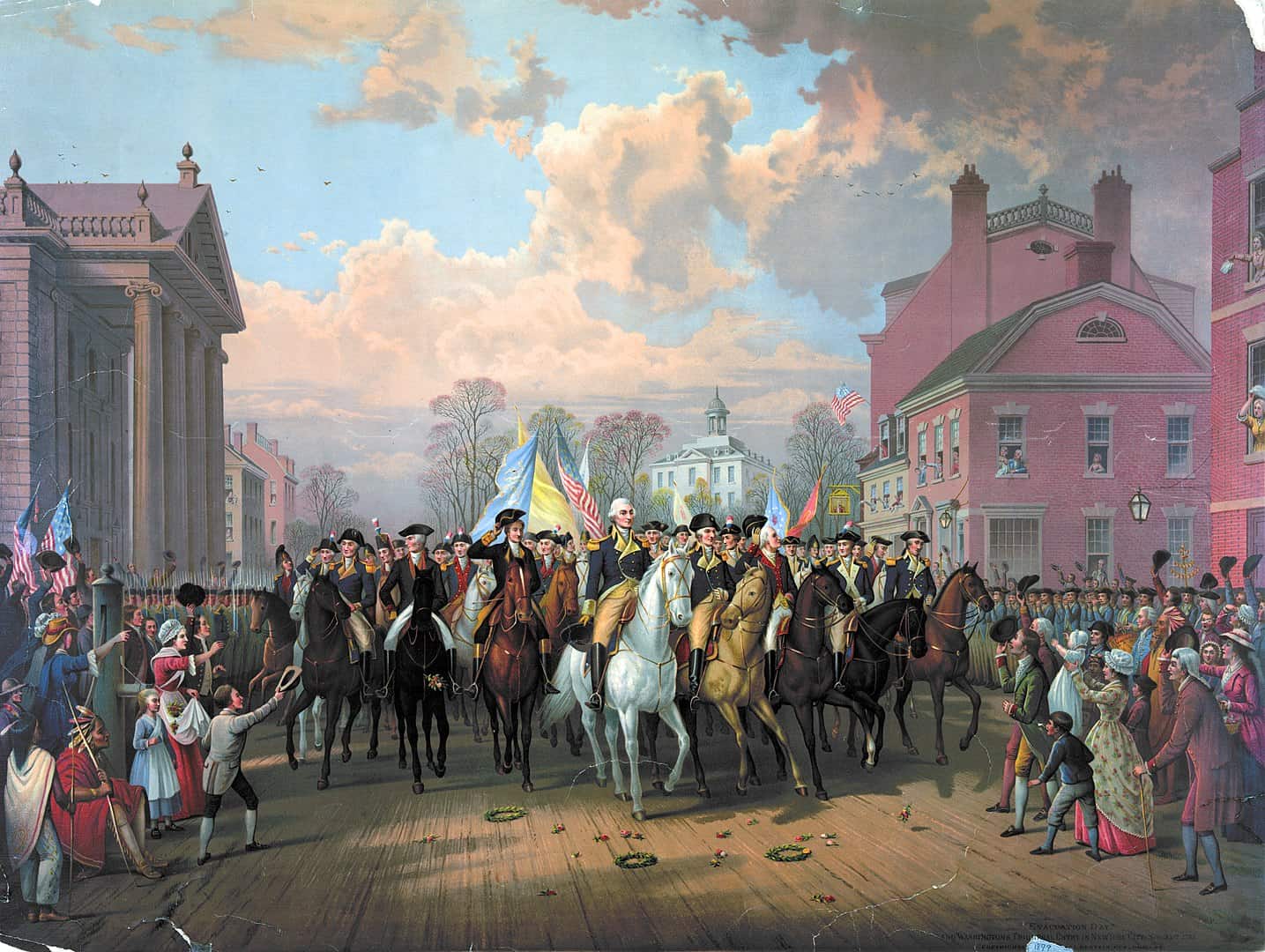
Thanksgiving has a connection with Halloween.
In New York, part of the Thanksgiving tradition once involved dressing up in costumes and wearing masks during celebrations. By the start of the 20th century, only children followed the tradition, forming so-called Ragamuffin Parades. By the 1950s, only small, rural communities continued to follow the old tradition. Eventually, children running around in costumes became part of the Halloween tradition in the USA.
Roosevelt changing the day Thanksgiving fell on had economic reasons.
Roosevelt officially changed the Thanksgiving date upon the suggestion of Federated Department Stores owner Fred Lazarus Jr. At the time, the USA suffered the Great Depression, and the president and his advisors had to do all they could to bring the country back on its feet.
Lazarus hoped that moving up Thanksgiving by a week would expand the shopping season and encourage people to spend more. If they spent more, then businesses could sell more, and also have more incentive to make products, thus encouraging the economy.
Not all states followed Roosevelt’s change of the day Thanksgiving fell on.
This resulted from the fact that the president’s declaration was technically not legally-binding without an Act of Congress. This meant it was up to the state governments whether or not to follow the president’s lead.
Until Congress passed an act to support Roosevelt’s decision, only 22 states followed his lead, while 23 did not. Texas, in particular, had the distinction of holding 2 Thanksgiving celebrations in those years. First, during the fourth Thursday of November, after Roosevelt’s lead, and second, during the last Thursday of November.
Turkey is a traditional Thanksgiving dish.
While many dishes are served on the holiday, turkey is the star of the show. In fact, some people actually call Thanksgiving ‘Turkey Day’ because of the dish. Traditionally, people serve their Thanksgiving turkeys stuffed and roasted, though some may also opt to deep-fry it.

Turkeys usually have brining as a preparation for roasting.
To prepare a Thanksgiving turkey, people would soak the meat in saltwater for as long as 4 days. This gives time for the salt to sink into the turkey, which improves its flavor and keeps the meat moist after cooking. Alternatively, you can also just dry brine your turkey, which involves rubbing salt and other spices into the turkey before you stuff and roast it.
It takes time to roast a turkey.
Depending on how heavy the turkey is, it takes hours to thoroughly roast a turkey. A 3-kilo turkey needs around 3 hours to roast, while an 11-kilo turkey needs around 7 hours to roast. A stuffed turkey usually takes another 30 minutes or more to cook than an unstuffed turkey.
Deep-Frying a turkey is much quicker.
A deep-fried turkey may seem uncommon outside the Southern States, but it may be the way to go if you’re in a pinch. At most, a deep-fried turkey only needs 45 minutes to finish, compared to the hours-long method of roasting. Depending on how big the turkey is, it can finish as early as 30 minutes. While you can pick any kind of oil, deep-fried turkey traditionally uses peanut oil.
Stuffing for the turkey comes in many varieties.
Breadcrumbs come as the usual base to make stuffing with, with other ingredients added to add flavor to both the turkey and the stuffing itself. You can go for vegetables like onions and celery, as well as simple flavorings such as salt and black pepper. You can also add herbs, most commonly sage, or even deli meats such as sliced sausages. While you usually put stuffing inside the turkey to cook with it, you can also cook more stuffing separately.
The US President traditionally pardons a turkey on Thanksgiving.
This goes back to President Kennedy when the National Turkey Foundation presented him with their traditional gift of a live turkey in addition to two dressed ones. He responded by having the live turkey released, as he wasn’t planning on eating it.
However, it was President Reagan who first presented an official Presidential Pardon on the turkey he’d received, which was then sent to a nearby petting zoo. His successor George H.W. Bush carried on the tradition, as has every president since. Definitely one of the more heartwarming Thanksgiving facts.
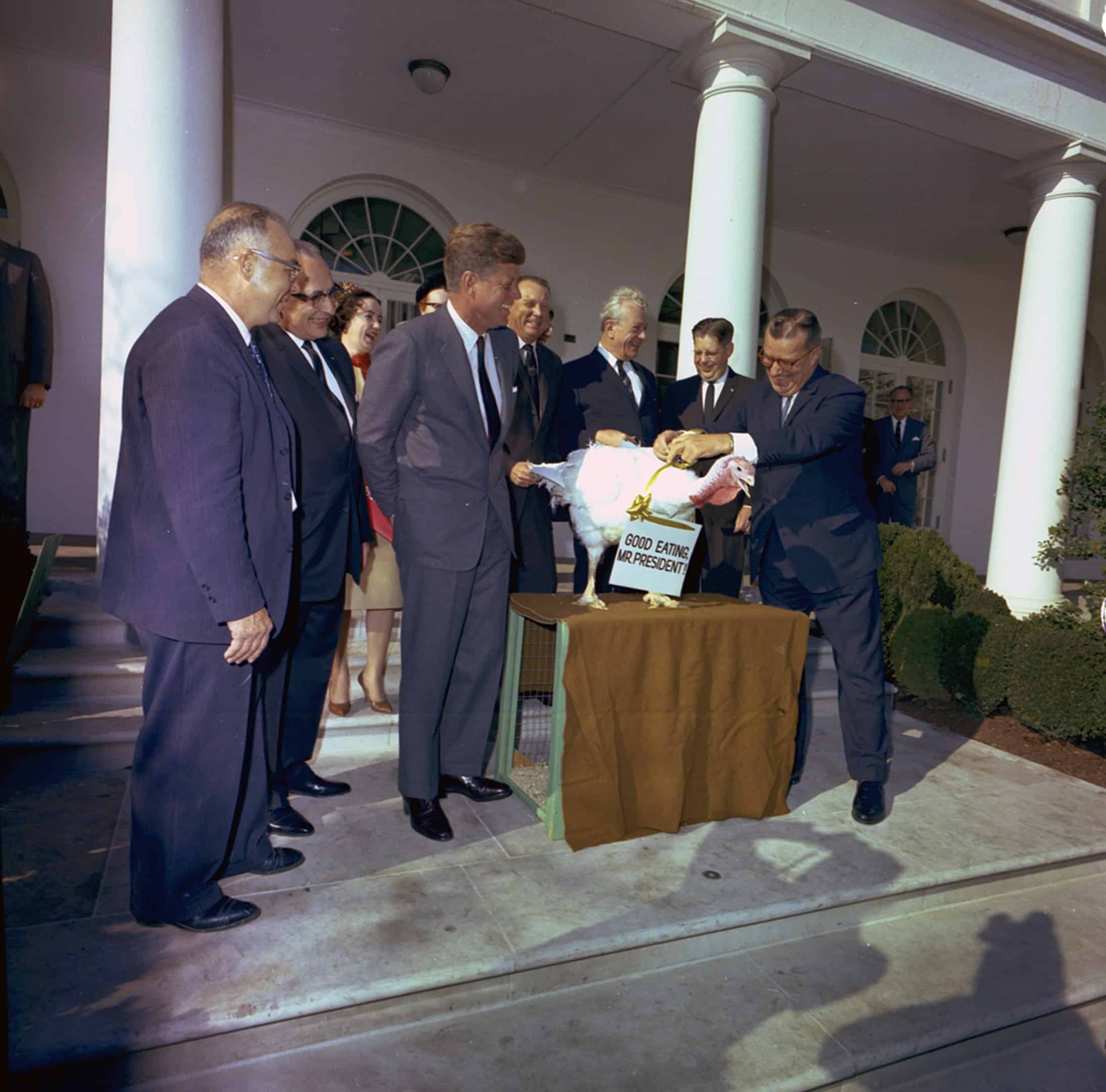
President Truman once tried to stop the practice of serving turkeys on Thanksgiving.
During a food shortage in the aftermath of World War II in 1947, President Truman encouraged Americans not to have poultry or eggs on Thursdays. This became problematic for Thanksgiving, which fell on a Thursday. After much public criticism, the President eventually agreed to make an exception for Thanksgiving.
Americans also sometimes have other meat dishes instead of turkey.
In many American homes, baked ham is a common alternative to turkey. For poultry, geese and duck are also cooked in place of turkey. In Texas, quail is another common alternative for turkey. Along the West Coast of the USA, crab is a common alternative as crab season actually begins in November. In Alaska, whale meat may be served instead of turkey.
Cranberry sauce is another traditional Thanksgiving dish.
The reason it’s served for Thanksgiving has an interesting story of its own. Apparently, cranberries were among the first edible foods the English settlers found in North America. They found the berries growing wild in what is now modern Massachusetts. That said, historians doubt that cranberries were ever served as a sauce in the 17th century, since the scarcity of sugar at the time meant that cranberries were more likely served by themselves.
It’s traditional to make your own cranberry sauce.
Commercial cranberry sauce first appeared on supermarket shelves as far back as the 1910s. That said, it feels more special when making your own sauce for your friends and family, even if it takes some work to do. Making cranberry sauce starts with boiling the berries in sugar water until they pop, after which you simmer the sauce while regularly stirring until it reaches the texture you want.
You can add more sugar to sweeten it, but you can also add other flavors like orange juice, cinnamon, and even ginger for an added kick.
Mashed potatoes are another common dish served for Thanksgiving.
Traditional Thanksgiving mashed potatoes simply combines milk, salt, and black pepper. The potatoes are then served with a side of gravy, to add more flavor for those who want it. The base used for the gravy may also come from the turkey – specifically, the turkey’s drippings. The mixture is then thickened with flour, before being served with both the potatoes and the turkey.
Green bean casserole is a new addition to the Thanksgiving menu.
Introduced in the 1950s, this dish came as a way to add the popular Campbell’s Cream of Mushroom soup to the American Thanksgiving menu. The company advertised it by using the soup as a base for a recipe that included green beans and fried onions.
Though the recipe initially struggled, it became mainstream not just for Thanksgiving, but also as a form of comfort food. Today, it’s estimated that 40% of the Cream of Mushroom soup that Campbell sells in the USA is used to make green bean casserole.
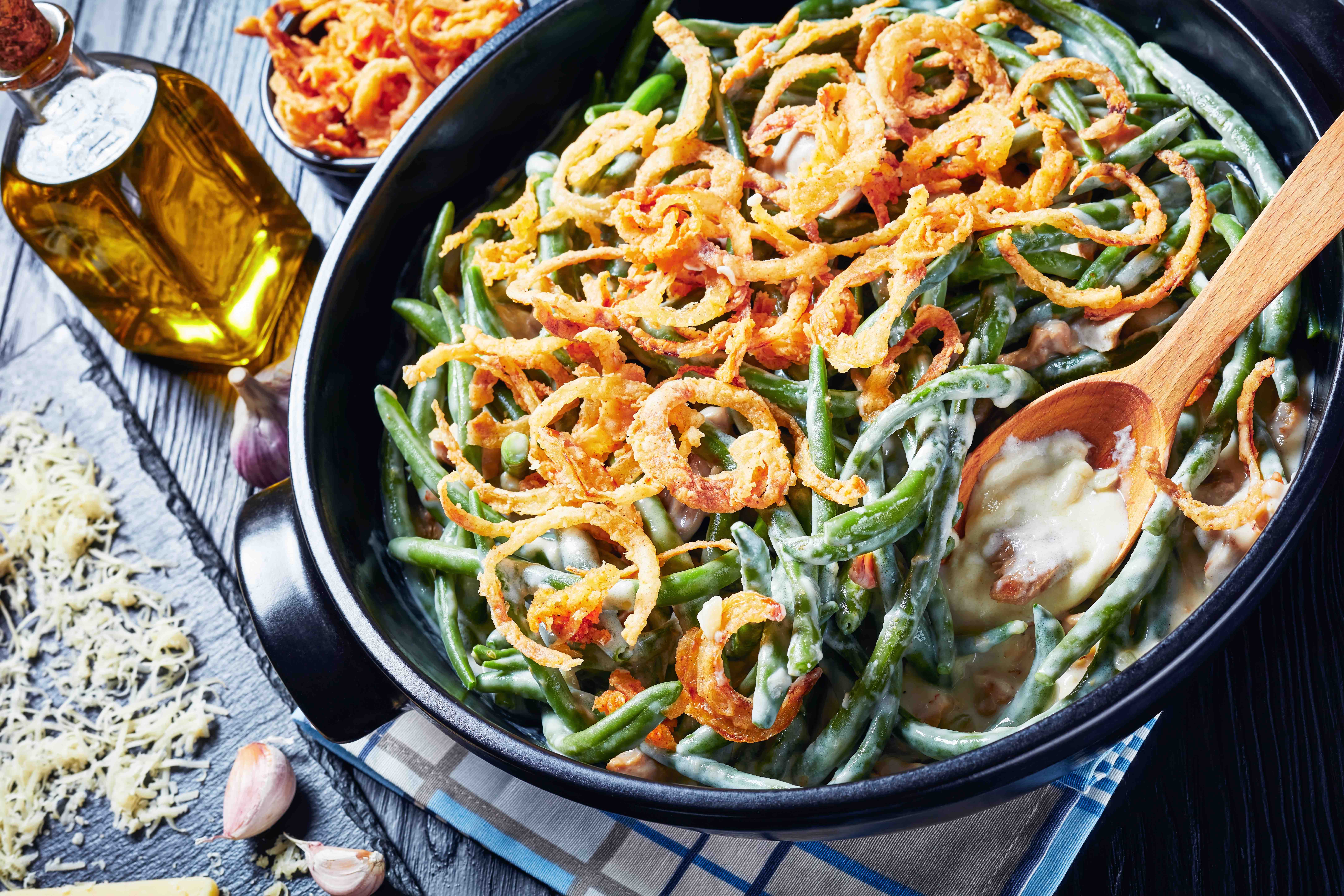
Pumpkin pie is a common dessert served for Thanksgiving nights.
Ironically, historians know that pumpkin pie was first served during the 19th century. Before then, pumpkins would usually get served in soups. From the 19th Century onward, though, pumpkin pies have become part of the holiday season not just in the USA, but also in Canada.
For this dish, pumpkin serves as a base for the custard filling for a hard, baked pie shell, which allows diners to hold the pie and eat it with their hands. Unlike other pies, pumpkin pies don’t usually come with a topping.
Charity is another tradition on Thanksgiving.
Most communities in the USA hold annual food drives, in order to distribute food to the poor and homeless on Thanksgiving. Similarly, many corporations in the USA sponsor charitable organizations or launch their own programs on Thanksgiving. The Salvation Army, in particular, recruits hundreds of volunteers in each locality for their Thanksgiving programs.
The religious aspect of Thanksgiving transcends individual religions.
Originally a Christian holiday, Thanksgiving traditions still retain some of that legacy. However, that doesn’t mean that the tradition contradicts or excludes followers of other religions. American Muslim scholars, for example, unanimously agree that there’s nothing about Thanksgiving that goes against Islamic teachings. If anything, the tradition of thanking God for His blessings over the past year is completely in line with the Islamic faith.
Philadelphia has the oldest Thanksgiving parade in the USA.
It’s also more commonly known as 6abc Dunkin’ Donuts Thanksgiving Day Parade, with the name coming from one of its sponsors, the Dunkin’ Donuts donut chain. The parade starts at the intersection of Philadelphia’s 20th and JFK Boulevard, crossing the latter to loop around city hall and finishing at the Philadelphia Art Museum. The parade is especially known for its balloons, which feature popular characters from cartoons, folk stories, comic books, movies, and TV series.
New York City also has its famous Thanksgiving parade.
Each year, New York holds the Macy’s Thanksgiving Day Parade, sponsored by the Macy’s department store chain. The parade starts from Manhattan’s Upper West Side to finish at Macy’s flagship store at Herald Square. It also receives sponsorship from NBC, which also broadcasts coverage of the event live. The parade is especially known for its floats, each of which has its own unique theme, and also includes live marching performances from Broadway.
The Macy’s Thanksgiving Day Parade always ends with a Christmas-themed float.
This ending float usually features a large depiction of Santa Claus, symbolizing the approach of Christmas. With Thanksgiving finished, Christmas is the next big holiday to look forward to.
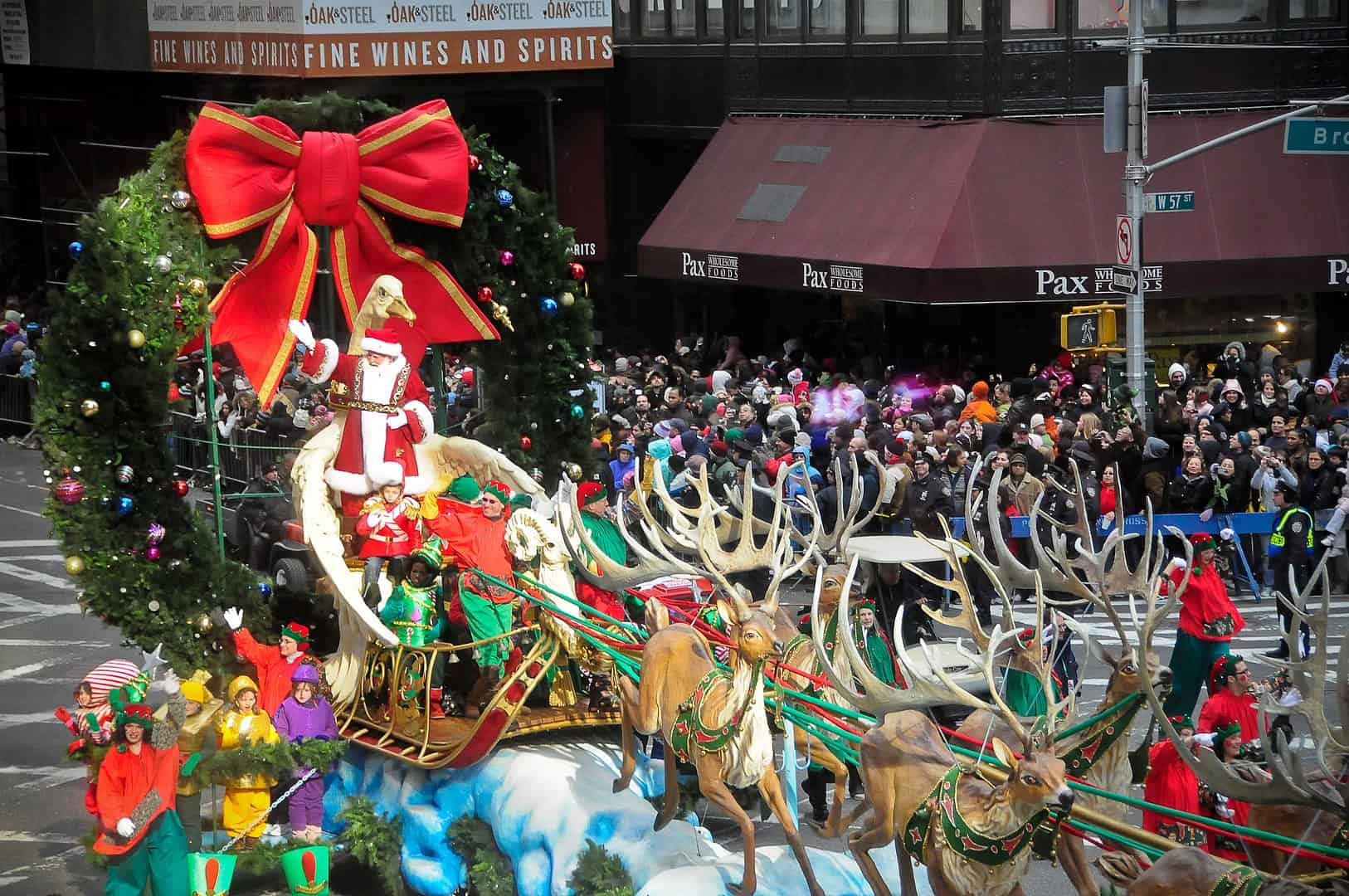
American football has a special relationship with Thanksgiving.
Professional leagues always have games on Thanksgiving night as the only games that don’t take place on Sunday or Monday. In particular, the NFL, has only stopped holding games on Thanksgiving night in World War II.
College basketball also has a special relationship with Thanksgiving.
University basketball leagues actually hold their elimination tournaments over Thanksgiving weekend, before the start of the conference season. The NBA also once held games over Thanksgiving weekends but stopped holding them since 2011, in the aftermath of a labor dispute.
Other sports have special relationships with Thanksgiving.
For one, the Turkey Night Grand Prix in Southern California takes place on Thanksgiving. Since 2011, the National Hockey League has also held its Thanksgiving Showdown each year. Similarly, professional wrestling associations hold special pay-per-view events on Thanksgiving night.
Thanksgiving has a dark history.
Many Native American activists don’t celebrate Thanksgiving, and criticize the holiday and its background. They argue that the holiday celebrates the destruction of both the people and the culture of the Native Americans at the hands of European settlers. Instead, they argue the holiday should get replaced with a national day of atonement, for the lives and cultures destroyed over the past centuries.
Thanksgiving criticism doesn’t get much attention.
The holiday’s importance to American culture and national identity means there’s little interest or support for critics. In fact, activists note that just trying to criticize Thanksgiving ends with the critic getting dismissed as a madman.
Was this page helpful?
Our commitment to delivering trustworthy and engaging content is at the heart of what we do. Each fact on our site is contributed by real users like you, bringing a wealth of diverse insights and information. To ensure the highest standards of accuracy and reliability, our dedicated editors meticulously review each submission. This process guarantees that the facts we share are not only fascinating but also credible. Trust in our commitment to quality and authenticity as you explore and learn with us.
